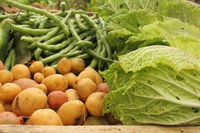Prairie Fare: Potatoes pack a nutrition punch
(Click an image below to view a high-resolution image that can be downloaded)
“Wow, look at these!” the children said.
“They’re purple!” another said.
“Here’s a red one!” someone else added.
Their enthusiasm nearly rivaled an archeological dig for dinosaur bones. They were digging potatoes and harvesting other vegetables at a garden plot for kids. They sorted and piled the colorful tubers.
Potatoes are available in a variety of colors, shapes and sizes. They have been part of the human diet for at least 7,000 years and made their way to America with Spanish explorers according to some accounts.
In early times, potatoes were used to treat scurvy because they are rich in vitamin C.
Potatoes are rich in potassium, which plays an important role in our heart health and in regulation of blood pressure. Potassium is among the latest additions to the Nutrition Facts label because of its role in health.
A reader recently asked me to comment on the 2024 “Dirty Dozen.” She was concerned because potatoes were included in the overall list, but not in the top 12. She loves potatoes.
If you have caught any of the latest social media posts on this topic, 46 foods were ranked by an environmental group according to the level of pesticide residues. This year’s top five list includes 1) strawberries, 2) spinach, 3) kale, collard and mustard greens, 4) grapes, and 5) peaches as having the most pesticide residues. Potatoes came in at No. 22.
All the foods on the list are foods that we in nutrition regularly promote for their nutritional value. Since I am neither a pesticide specialist nor a potato breeder, I asked the experts at NDSU to comment on potatoes and pesticides. They sent resources and excellent comments.
Were any of the “dirty” foods dangerous according to the level of pesticide residues? No. In fact, even organic fruits and vegetables can have some level of allowable organic pesticides from natural sources.
Pesticides are regulated by the Environmental Protection Agency. Exposure to pesticides from all sources must represent a “reasonable certainty of no harm.”
The Food and Drug Administration enforces pesticide tolerances. Even when detectable levels of pesticides are found, the levels must be within safe levels for human health.
After reading the information, I do not plan to change my recommendations to promote eating more fruits and vegetables. About 90% of adults fall short of the fruit and vegetable recommendations.
The health benefits of eating more fruits and vegetables outweigh the risks of any pesticide exposure.
What can a savvy consumer do? The FDA recommends rinsing fresh produce thoroughly under running water. That is true whether the fruits and vegetables are organically or conventionally grown. Rinse fruits and vegetables whether you buy them in a grocery store, farmers market or pick them in your backyard.
One exception: the prebagged, triple-rinsed salads are ready serve.
Contamination of produce with germs from unwashed hands and other sources is a greater risk than contamination with pesticides.
Running water and a vegetable brush are effective in removing soil, germs and, potentially, pesticide residues. You can skip the fruit and veggie washes. Place soft fruits such as strawberries and grapes in a colander and run water over them.
Remove the outer leaves of lettuce, and peel peaches. If you peel vegetables, do so thinly because many nutrients are directly under the peeling.
If you apply pesticides in your garden or yard, do it safely. Follow the directions on the container and wear appropriate protective gear. Farmers participate in pesticide application certification programs. Learn more at the National Pesticide Information Center at http://npic.orst.edu/health/index.html.
Here’s an interesting twist on a fudgy treat, with a not-so-secret ingredient: mashed potatoes. When NDSU potato breeder Susie Thompson mentioned potato brownies in a Field to Fork webinar, several people asked for the recipe. We made them, and we all agreed: they were very delicious. Visit www.ag.ndsu.edu/fieldtofork to view the 2024 webinars, including one about potatoes.
Potato Brownies
1 ⅔ cups sugar
¼ teaspoon salt
1 cup flour
1 cup mashed potatoes (without butter and salt)
1 ½ cups semisweet chocolate chips
¾ cup butter or margarine
1 teaspoon vanilla extract
4 eggs
½ teaspoon baking powder
Powdered sugar
Melt chocolate and butter/margarine in a saucepan on top of the stove (or in a glass dish in the microwave). Cool slightly. Cream sugar, vanilla, salt and eggs. Mix well. Add chocolate mixture and potatoes, flour and baking powder. Beat until creamy. Pour into a greased and floured 9 x13 oblong cake pan. Bake at 350 degrees for around 30 minutes. Let cool. Sprinkle powdered sugar on top.
Makes 24 brownies. Each brownie has 200 calories, 10 grams (g) fat, 26 g carbohydrate, 2 g protein, 1 g fiber, and 170 milligrams sodium.
(Julie Garden-Robinson, Ph.D., R.D., L.R.D., is a North Dakota State University Extension food and nutrition specialist and professor in the Department of Health, Nutrition and Exercise Sciences.)
NDSU Agriculture Communication – May 16, 2024
Source: Julie Garden-Robinson, 701-231-7187, julie.garden-robinson@ndsu.edu
Editor: Elizabeth Cronin, 701-231-7006, elizabeth.cronin@ndsu.edu




